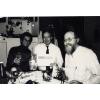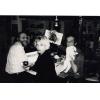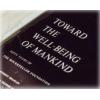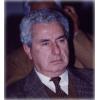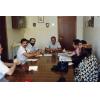On January 2 of 1990, David Ecker, member of the 1992 CCC (Christopher Columbus Consortium), arrived in Rome. He was also Sandro’s Ph.D. adviser at New York University and director of ISALTA (International Society for the Advancement of Living Traditions in Art), a non profit established in 1981 in New York to sponsor inquiry into creative, critical, and theoretical aspects of art traditions world-wide for the purpose of advancing living traditions in art.
Sandro went with David Ecker to meet prof. Carlo De Marco, Dean of the School of Medicine of University of Rome “La Sapienza,” who was Sandro’s former professor when in the 70s he was working there as a biochemist researcher, to discuss with him a proposal of a collaboration with the Columbus Consortium, in order to organize a cultural navigation project addressing the Academy and the Community on the theme of “new worlds of discovery”.
Dean De Marco found that what they were discussing was closed related to the issues raised by the World Health Organization in the Declaration of Alma Ata and also recently highlighted in the book Toward the Well Being of Humankind by Robert Shaplen and published by the Rockefeller Foundation that he gave to Sandro by suggesting that “well being” might serve as a concept lending itself to productive cross-disciplinary analyses, to address physiological, psychological, social, artistic, and ecological approaches toward an integrated worldwide vision of human well-being. He proposed to hold a preliminary round-table discussion at the University of Rome “La Sapienza” in the middle 1990 with a small group of international experts to test this idea which could well lead to fruitful cross-disciplinary research proposals for the 1992 Columbus event.
The day after, Sandro and Ecker left for Sardinia, where in Cagliari Ecker and Meloni discussed about the data contained into the“Plexus Black Box” and their similar interests in the epistemological problems arising over the electronic packaging of text, images, and sound from disparate cultures. Meloni raised Godel’s problem on the seemingly infinite regress of meta-structures and the impossibility of achieving coherence within a system. Ecker’s view, not incompatible with Meloni, was that it was a mistake to seek equivalence of meaning across cultures and he proposed a phenomenological/hermeneutical approach, by placing their ideas about packaging in a practical working context, such as the project of ISALTA of the Encyclopedia of Living Traditions in Art, at both level quantitatively and quantitatively.
On January 5th roundtable at Villanovaforru with Ubaldo Badas, Director of the Park and Archaeological Museum Genna Maria, the Mayor Giovanni Pusceddu of Villanova, Franco Meloni and Sandro. Ecker presented his thoughts on the need to coordinate efforts to preserve and advance living traditions in art around the world. It underlined the e existing gap in public awareness between the archaeological past and contemporary culture. He stressed how the establishment of communication channel among individuals and institutions across cultural boundaries might serve to promote global consciousness of the human value of cultural diversity, and the preservation of living traditions could make a vital contribution to this goal. Therefore he proposed to establish a channel of communication between ISALTA and the Park and Museum Genna Maria as a joint effort toward the projected events of the 1992 CCC.
In early March, after several clarifications among Arturo Lindsay, Sandro Dernini and other Plexus historical players about the presence of Plexus International in the 1992 Columbus event as not a “celebration” but as a “reconciliation” event, it was agreed that during the same time of the 1992 CCC meeting at the University of Rome “La Sapienza”, planned on July 2, at the Institute of Psychology of the School of Medicine”, to have also in Rome the First Plexus International conference on art, science and technology, in order to re-organize Plexus International as a network and to discuss all issues raised up from the packaging of Plexus into the Black Box, which in the meantime became the new subject of the Ph.D. dissertation of Sandro at New York University, after that David Ecker, his chairperson of the dissertation committee, felt not feasible for Sandro to continue his original study research on “the bio-need of art”.
Around the same time, at the University of Cagliari, Franco Meloni joined the Mediterranean coordination committee of the 1992 CCC in direction of the preparatory meeting at the University of Rome “La Sapienza” on July 2. In reference to the Plexus Black Box, Meloni wrote to Ecker:
Dear David, it is a pleasure for me to continue our long-distance dialog on some common arguments of interest. In a sense, PLEXUS means connections and transmission of knowledge. In particular, remembering once more the absolute necessity to connect our places of work by computer electronic mail, I want to continue to play with the Black Box. First of all, we must give a definition of it.
The Black Box has been created in order to survive. To survive against the complexity of the problems that made uncontrolled the route toward a common goal. To survive against the egoism of many of the participants to the project. To survive against of the responsibility of the ambitious target, more or less future. To survive against the fragmentation of the different objectives of PLEXUS.
In this way, the Black Box represents a quiet place created to discuss the situation according to a scientific method. BUT is it possible to do it? Clearly not. To go back to play, I think that it is denied by arguments based on Godel considerations. To be clear, for the fact that the BB is a superstructure of PLEXUS, but all of us are contemporary in the two And seems that the process should go to infinity in creating spirally involved superstructures. It is impossible to assume a position totally external, in physical and in human sense, that could allow a scientific, unperturbed and un perturbing vision of this - but not only this - reality. This is a problem concerning the thesis work of Sandro too His job is practically impossible to be brought to a definite end for his intimate involution in the problem. It is a kind of symbiotic process between PLEXUS and Sandro that makes hard to individuate the subject and the object of the analysis. And this is strongly exciting. It resembles some situations in the interactive process of the measure, according the quantum mechanics, of microscopic entities. Now, how to solve the problem? In physics we proceed by putting in an organized way the results of the experimental tests. For the BB we need, first of all, to create a chronological order - Time Art ? - in order to fix some well defined coordinates. And this is what you suggest for the Sandro's thesis. All the possible developments should come as a consequence of this first task. We must then collect our energies to meet together – in Amsterdam, in Rome, in Carloforte - to find the right answers for our problem.
Arrivederci, Franco Meloni, Cagliari, March 3, 1990
At the end of April 30, Sandro invited Frans Evers, director of the Plastic Sound Laboratory of the Royal Conservatory of the Hague, to participate at the Plexus International conference in Rome, preceded by a three days “Black Box” laboratory, in order also to bring with him the Black Box to his laboratory at the Conservatory, to be open as an alive creature on the anatomy table of the Academia.In order to have a participation from the University of Cagliari at the 1992 CCC preparatory meeting at the University of Rome “La Sapienza”, on May 16, at the Institute of Biochemistry where Sandro was trained as a biochemist by the Dean De Marco in early 70’s, it was held a first meeting with participants from different scientific disciplines, Augusto Rinaldi (Director of Biochemistry Institute), Francesco Aymerich (Director of CIFRA Consortium Informatics), Bruno Picasso (Director of Engineering Dept.), Marco Mameli (Genetics), Franco Meloni (Physics Dept.), Walter Raccugno (Mathematics Dept.), Antonio Ulzega (Geological Sciences Dept), in which it was agreed to proceed with the drafting of a 1992 Manifesto from Sardinia for a route correction in knowledge transmission. On July 4, in the Island of San Pietro, David Ecker, Okechukwu Odita and Sandro Dernini, as representatives of the 1992 C. Columbus Consortium, together with Francesco Aymerich of the University of Cagliari, presented to the Mayor of Carloforte the proposal to organize in 1992 the Well Being Columbus Forum on the occasion of the 1992 Columbus Day. They presented also the project of The Voyage of Elisabeth, The Caravel of Art, made in collaboration by Plexus International and ISALTA-Mediterranea, to promote the opening in Goree of the World Art Bank in order to survive the masters of the living arts traditions. On July 5, at the Archeological Museum of Villanovaforru, near Cagliari, David Ecker, Sandro, and Franco Meloni presented to Ubaldo Badas “Plexus Black Box” as a framework proposal, made in collaboration by Plexus International and ISALTA, for the development of a data bank to catalogue and retrieve information regard the masters of Sardinian living traditions in art.In September, Dean De Marco invited Francesco Aymerich as president of the CIFRA Consortium to assume the responsibility of the organization of the network of the telematic communication to acquire the data on which to build the 1992 Columbus Well Being symposium, to be held on the Columbus Day 1992 at the S.Pietro Island. In October, at the Dean De Marco’s studio at the University of Rome “La Sapienza”, it was established an Italian organizative committee for the Well Being symposium made by Carlo De Marco, Sandro Dernini, Francesco Aymerich, Renato Lazzari and Mario Giancotti, vice president of the International Institute of Epistemology “La Magna Grecia”.


